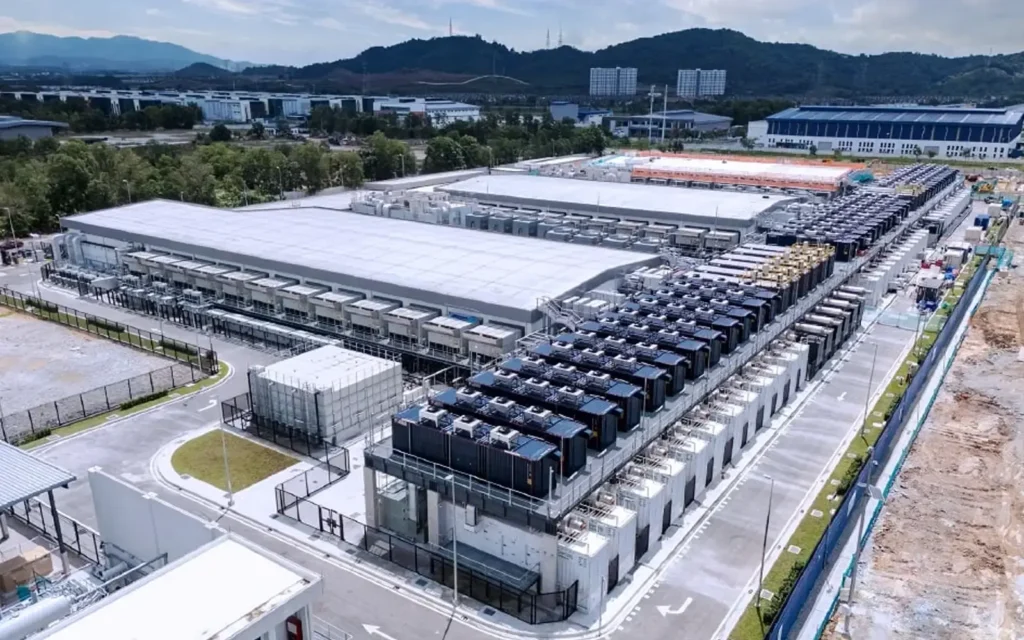
View of the initial phase of AirTrunk JHB1 hyperscale data center in Johor Bahru, Malaysia. Image: Hyperlink Digital News Asia
By Mariana Meneses
The reactivation of the Three Mile Island nuclear plant by Microsoft highlights the growing urgency around the immense energy consumption of modern data centers, particularly those supporting artificial intelligence (AI) and cloud computing. The site of a near-catastrophic nuclear meltdown in 1979, and shut down in 2019 due to operational issues, the plant’s revival signifies the extent to which tech giants are willing to go, paying above-market rates to secure stable and sustainable energy for their power-hungry operations.
The decision to bring back this nuclear facility underscores the accelerating demand for energy as companies grapple with the strain caused by AI workloads, and signals how critical energy stability has become for tech leaders like Microsoft.
In Australia, the hyperscale data center specialist AirTrunk has opened a massive new data center in Johor Bahru, Malaysia. This center is designed to be energy-efficient and uses advanced cooling systems to prevent overheating. Designed to help big cloud and AI companies grow in the region, the center is part of AirTrunk’s larger network in the Asia-Pacific region, which has a lot of capacity to handle data and computing power.
AI’s rapid growth is pushing data centers to redesign their layouts to handle more power and heat, as new AI applications now use far greater amounts of energy than previously. This is because AI increasingly relies on specialized hardware like GPUs (Graphics Processing Units), TPUs (Tensor Processing Units), and accelerators, which are designed to handle the heavy calculations needed for AI tasks more efficiently than regular computer chips.
The AI for Good Global Summit annual summit was held in Geneva in May 2024. It addressed a range of topics including brain-machine interfaces, AI in space, robotics, quantum computing, and language technology. AI for Good is a year-round project organized by the International Telecommunication Union (ITU), the United Nations specialized agency for information and communication technologies, in partnership with 40 United Nations Sister Agencies. The goal of AI for Good is to identify practical applications of AI to advance the United Nations Sustainable Development Goals and scale those solutions for global impact.

The environmental challenges of AI are crying for attention. Image: fungidev, via Hyperlink Deviant Art.
The upcoming global AI summit, set to take place in France in February 2025, is expected to put the spotlight on the environmental impact of AI technologies and their effect on the labor market, emphasizing the urgent need for transparency and sustainability.
A key proposal under consideration is to rank AI companies based on their ability to meet climate goals, with an emphasis on transparency. The summit aims to push companies to disclose their environmental data, with firms that lack transparency being flagged. This summit follows the UK’s AI safety gathering in 2023, which shifted global discussions away from existential risks toward more immediate and tangible issues like environmental impact and regulation.
Creating a single AI-generated image can consume as much energy as fully charging a smartphone, contributing to significant carbon emissions.
That’s the conclusion of a study by researchers from Hugging Face and Carnegie Mellon University, titled “Power Hungry Processing: Watts Driving the Cost of AI Deployment?”, and published in June. The authors note that text generation is less energy-intensive, using only 16% of the energy required for image generation. Importantly, the emissions from frequently using AI models can exceed those from their initial training, with popular models like ChatGPT surpassing their training emissions in just a few weeks of use.
How much of the world’s energy are data centers now consuming?
Despite strong efficiency improvements in recent years, global data centers are still seeing notable growth in electricity consumption, with their global energy use reaching an estimated 240-340 TWh in 2022, accounting for around 1-1.3% of the world’s total electricity demand, according to the IEA.
For comparison, the average American home consumes 900 kWh a month (and a terawatt-hour (TWh) is a 1,000,000,000 kilowatt-hours (kWh), which means that one TWh could power more than 900 American homes for 100 years). It’s noted that this does not include the substantial 110 TWh used for cryptocurrency mining, which made up 0.4% of global electricity consumption last year.
While efficiency gains in IT hardware, cooling, and a shift from small, inefficient data centers to large cloud and hyperscale facilities have helped slow the growth of energy use, the rapid increase in workloads managed by these centers continues to drive significant energy demand, especially in large data centers, where energy use is still increasing by 20-40% annually, according to the IEA. For example, the electricity consumption of tech giants Amazon, Microsoft, Google, and Meta more than doubled from 2017 to 2021, reaching around 72 TWh in 2021. Although global data center energy use (excluding cryptocurrency) may continue to grow only moderately, certain countries are experiencing much sharper increases.
Ireland, for instance, has seen its data center electricity use more than triple since 2015, with these centers accounting for 18% of the country’s total electricity consumption in 2022. This could rise to 28% by 2031 if generation capacity doesn’t keep pace. Similarly, Denmark is projected to see a sixfold increase in data center energy use by 2030, which could account for nearly 15% of the nation’s total electricity consumption, highlighting the ongoing challenges posed by the expansion of digital infrastructure.
There is also the related issue of CO2 emissions.
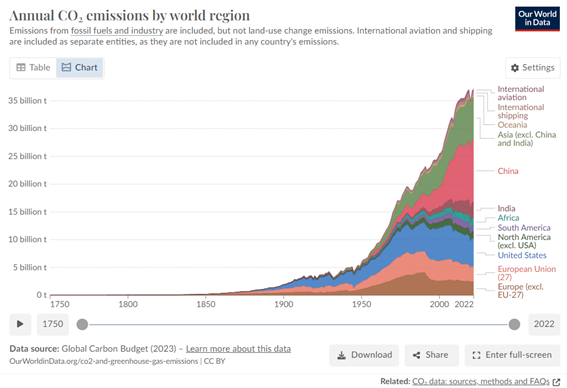
Annual CO2 emissions by world region. Image: Hyperlink Our World in Data – CO2 emissions
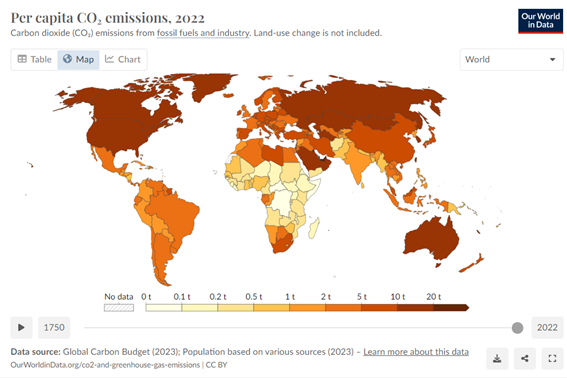
Per capita CO2 emissions, in 2022. Image: Per capita CO2 emissions, in 2022. Image: Hyperlink Our World in Data – CO2 emissions
Despite these alarming trends, there is reason to hope that the 2025 summit could drive meaningful change.
A report by the U.S. Department of Energy (DOE) highlights how AI can help meet growing electricity demand, partly driven by AI and data centers, by improving grid planning, resilience, and clean energy innovation. AI tools can streamline processes, accelerate the development of a 100% clean electricity system, and assist in identifying new materials for cleaner energy technologies. The DOE’s voltAIc Initiative, launched in 2024, aims to develop AI solutions to support clean energy infrastructure deployment at the federal, state, and local levels, enhancing public engagement and environmental outcomes.
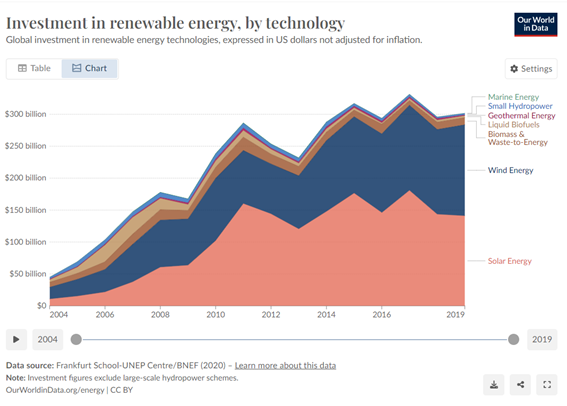
Investment in renewable energy, by technology. Image: Hyperlink Our World in Data
According to the IEA, global investment in clean energy technologies and infrastructure is set to reach $2 trillion in 2024, nearly double the amount spent on fossil fuels, despite challenges posed by high financing costs, especially in developing economies. While global energy investment will surpass $3 trillion for the first time, clean energy spending remains concentrated in advanced economies, with China, Europe, and the U.S. leading the way. The IEA report highlights a critical shortfall in clean energy investment in emerging economies, where high capital costs hinder progress. Solar PV investment is driving the clean energy surge, with $500 billion expected in 2024, as module prices decline and demand grows.
Despite a challenging 2023 marked by record-breaking temperatures and a narrowing window to limit global warming, there are reasons for optimism in the energy transition, according to the World Economic Forum’s 2024 Energy Transition Index.
Key enablers such as regulation, infrastructure, and financial investment show positive trends, supporting the shift toward a low-carbon future. Notable developments include a surge in global renewable energy capacity, the European Union’s new directive criminalizing serious environmental destruction, and seven countries now fully powered by renewable energy. Additionally, the world’s largest offshore wind farm is now operational, and renewables are on track to surpass coal as the leading energy source by 2025. While progress is evident, the pace of change remains a critical concern in the race to achieve net-zero emissions.
The growing challenge of managing energy consumption in data centers that support large language models, as highlighted in the March 2024 paper “Towards Greener LLMs: Bringing Energy-Efficiency to the Forefront of LLM Inference“, by researchers from the University of Illinois and Microsoft. The deployment of powerful GPUs has increased energy demands, making efficiency a critical concern. The authors discuss trade-offs between energy use and performance and suggest optimizing server configurations to match different workloads. They call for new strategies to adapt to dynamic LLM tasks, aiming for more sustainable and energy-efficient systems.
Looking for ways to lower energy consumption in data centers hosting large language models, the paper from the University of Cambridge titled “Hybrid Heterogeneous Clusters Can Lower the Energy Consumption of LLM Inference Workloads” proposes a hybrid data center model that dynamically allocates LLM tasks across various hardware types based on their energy efficiency and computational power.
Utilizing a cost-based scheduling framework, the model optimally decides whether to process tasks on energy-efficient processors or powerful GPUs, tailored to the specific requirements of each query. The study demonstrates that this hybrid approach can reduce energy consumption by 7.5% compared to traditional methods, enhancing the sustainability of data centers while preserving performance.
Does quantum computing promise significant reduction in power consumption?
Christian Weedbrook, the founder and CEO of quantum computing company Xanadu, has been at the forefront of advancing photonic quantum computing with the hope that quantum technology will not only reduce power use but also rapidly advance innovation and discovery of new technologies for efficient energy production. The Canadian quantum computing company has developed a photonic quantum computer that operates at room temperature, avoiding the energy costs associated with extreme cooling required by other quantum computing architectures.
Weedbrook has contrasted the current low profile of quantum computing with the massive attention given to AI, suggesting that quantum technology could soon experience a similar surge in interest. He points out that computations in data centers “are bounded by the domain of classical physics,” and that “Quantum computing goes beyond this and enables exponential improvements in efficiency, allowing far more to be done per kilowatt-hour (kWh) of energy on certain applications.”
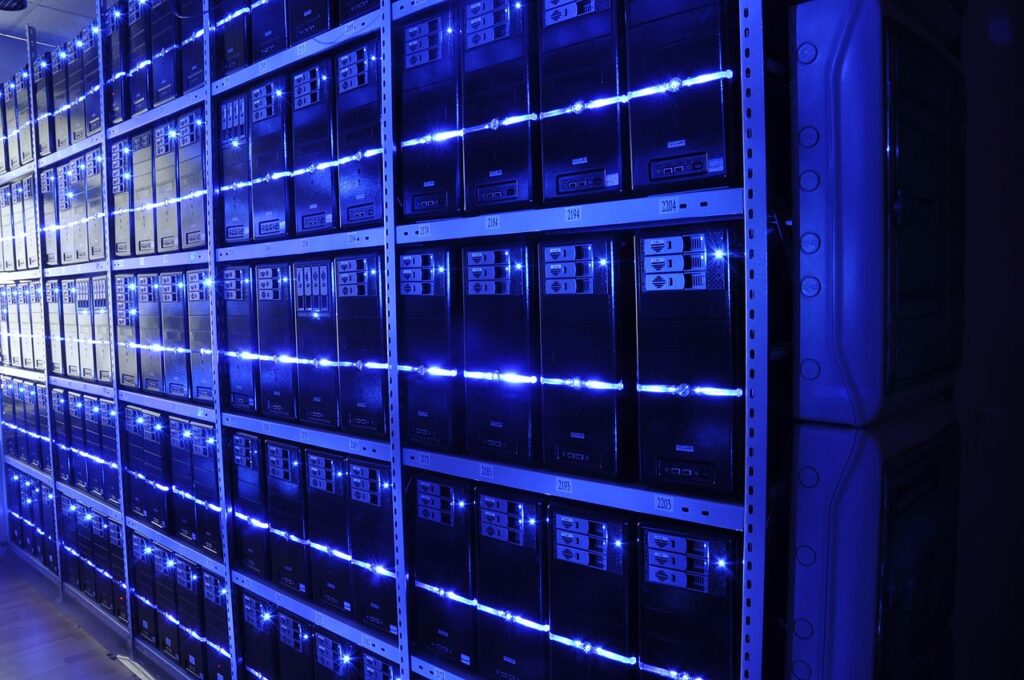
2013 – Server room of BalticServers. Image: BalticServers.com
The increasing energy demands of modern data centers, particularly those supporting AI and cloud computing, are prompting significant shifts in energy strategies and technologies.
The revival of the Three Mile Island nuclear plant by Microsoft underscores the urgent need for stable and sustainable energy sources, while advancements in hybrid data center models and photonic quantum computing offer promising avenues for enhancing energy efficiency.
As the global demand for AI and data processing continues to grow, international discussions and initiatives among tech companies, national states, and international organizations focused on clean energy investment and innovative technologies are crucial for mitigating environmental impacts. With upcoming events like the global AI summit, there is hope that increased transparency and collaboration across sectors will lead to meaningful changes in energy consumption practices.
Ultimately, balancing the energy needs of emerging technologies with sustainability goals will be essential for fostering a greener future in the digital landscape.
Craving more information? Check out these recommended TQR articles:
- Race for Post-Quantum Cryptography: Will Proposed Encryption Standards Secure the World’s Data?
- What Will a Recent Quantum Leap in Time Crystal Technology Reveal About the Elusive Nature of Time?
- Breakthrough in Error Correction Opens Potential for Large-Scale Quantum Computer Processing
- The Future of Quantum Computing Accelerates, Many Qubits at a Time
- The Incredible Power of Shape: Fractals Connect Quantum Computers to the Human Body and the Cosmos
Your feedback helps us shape The Quantum Record just for you. Share your thoughts in our quick, 2-minute survey!
☞ Click here to complete our 2-minute survey




